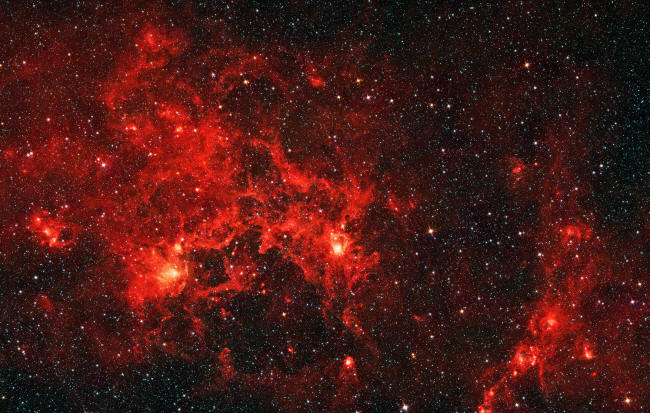|
by Phil Plait
from
ScientificAmerican Website This infrared image from NASA's Spitzer Space Telescope shows the nebula nicknamed "the Dragonfish." This turbulent region lies beyond the galactic center - effectively on the dust-obscured "far side" of our galaxy - and is home to some of the most
luminous massive
stars in the Milky Way.
astronomers can pierce the dusty veil of our galaxy and map its farthest reaches...
We see every other galaxy from the outside,
allowing us to observe most of them sprawled out before us. That
makes mapping their structure relatively easy.
Imagine you're in a giant, fog-filled warehouse where you can always see the floor and ceiling, but the gloom blocks any deep view to the building's perimeter.
Astronomers face this very issue.
If our galaxy were just made up of stars, we'd be able to see clear across it. But it's also filled with dust: tiny grains of rocky or sooty material created when massive stars die, blown out in a vast wind that expels the grains into space.
Billions of these stars over billions of years have choked the Milky Way with dust, filling it with opaque clouds, blocking our sight line and limiting our view.
Essentially all the stars we can see are on our "near" side of the Milky Way. Still, we can say with utmost confidence that our galaxy is a flat disk with a roughly spherical central bulge of stars; on a dark, moonless night we see this as a broad river of light across the sky that blossoms outward into a circle near the constellation Sagittarius.
We're inside that flat disk, so the all the visible stars' combined light produces that misty stream (called the Milky Way - confusingly, our galaxy as a whole is also named after it).
I have good news:
Well, I didn't lie so much as withhold some information.
Although the disk's ubiquitous dust blocks visible (also called "optical") light, other, longer wavelengths of light such as radio waves and infrared can slip through that dust relatively unimpeded.
So by using telescopes sensitive to those wavelengths, we can see much farther and learn what lies beyond our own eyesight.
For example, the center of our galaxy is obscured by so much dust that optical light telescopes are nearly useless, but with infrared telescopes, we can see the light emitted by objects there.
Using such instruments, astronomers have been able to track stars so accurately that their stellar motions have revealed and even weighed a monstrously huge object at our galaxy's center that emits no visible or infrared light:
Radio waves have a longer wavelength than infrared and can pass through dust even more easily. In 2010 astronomers detected a gigantic gas cloud 31,000 light-years from Earth, on the other side of our galaxy.
Follow-up observations in infrared revealed it to be an immense cloud of gas and dust in which stars are actively forming; the astronomers named it the Dragonfish Nebula because of its resemblance to the tropical fish.
It's two degrees across in the sky - four times as wide as the apparent size of a full moon - which, given the nebula's astronomical distance, makes it a staggering 1,000 light-years wide; compare that with the Orion Nebula, a relatively nearby stellar nursery that is only a couple of dozen light-years across. The Dragonfish is likely the largest such nebula in the Milky Way, making it easily visible even from other galaxies, yet it's entirely invisible to our optical telescopes.
Still, we can do even better.
By combining the observations of telescopes around the world, we can get ultraprecise measurements of their motions and distances.
These clouds lie along the galaxy's winding, star-studded streams: its spiral arms. In fact, observations of these masers have proved that our Milky Way is a magnificent example of a spiral galaxy.
Astronomers have observed that our galaxy has four large-scale arms.
But there's also a fifth arm, not as large or obvious, that tracks less than a quarter of the way around the galaxy:
Other radio astronomy measurements have pinpointed our galactic coordinates with considerable precision:
G1.9+0.3 is another galactic far-side object found in observations by the Very Large Array, a series of radio telescopes located in the New Mexico desert.
It's a supernova remnant, the expanding gaseous debris from a star that exploded.
The light from this explosion reached Earth only a little over a century ago, making it the most recent known supernova in our galaxy, but the intervening dust dimmed it so much it wasn't seen in visible light at all.
Its location is estimated to be over 27,000 light-years from Earth, putting it just barely on the galaxy's far side.
X-rays can penetrate our galaxy's dust as well. In 2004 a huge wave of this kind of high-energy light swept over Earth, blasted out by a magnetar:
The explosion was so powerful that it swamped satellites designed to measure the x-ray sky and physically affected Earth's atmosphere.
And it did this from a distance of 40,000 to 50,000 light-years, clear on the other side of the Milky Way.
Magnetars are relatively rare - only a handful are known in our galaxy, and all of those except SGR 1806-20 are on our side of the galactic center.
It's likely there are more located on the other side that are (hopefully) less powerful than that one. Clearly the hidden half of our galaxy is worth exploring!
Our local volume of space is filled with amazing objects, such as powerful Wolf-Rayet stars blasting out waves of dust, stars that are just on the edge of exploding and exoplanets galore, just to name a handful.
What other treasures lie in wait to be discovered on the other side?
Until we can further explore the Milky Way's more distant reaches, our galactic census is, at best, only half-complete.
|


